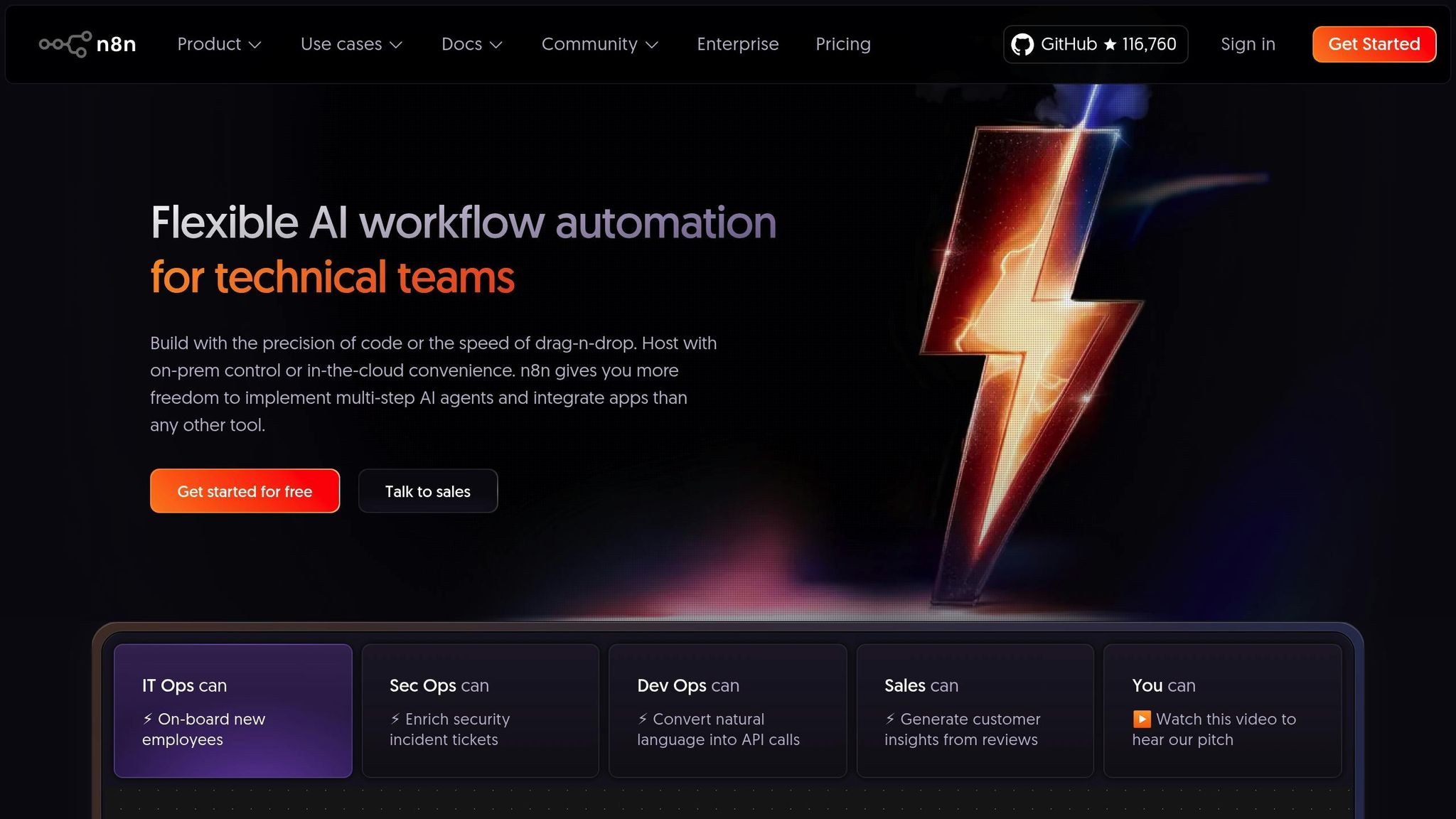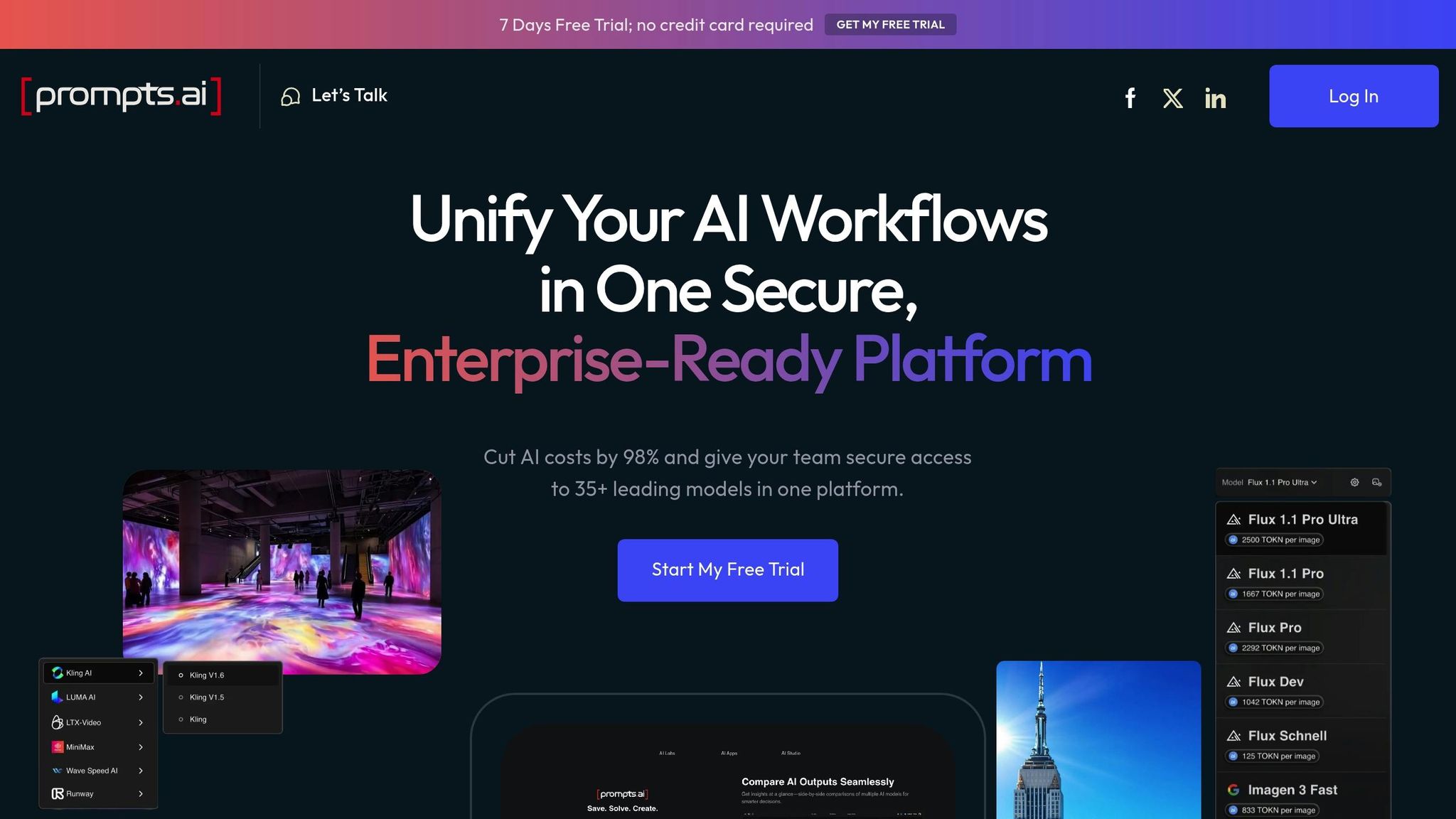
Generative AI is transforming how organizations handle task scheduling and resource allocation. By processing large datasets and offering real-time insights, it automates repetitive tasks, predicts outcomes, and optimizes workflows. Here's what you need to know:
Platforms like prompts.ai specialize in integrating these capabilities into existing systems, offering tools for real-time collaboration, automated adjustments, and secure data handling. While challenges like data privacy and initial setup remain, the potential for improved efficiency and decision-making is clear. The choice between general AI solutions and specialized platforms depends on an organization’s needs and infrastructure.

Generative AI is reshaping the way organizations handle task scheduling and resource allocation by automating decisions that previously required significant manual effort. These systems process vast amounts of data simultaneously, creating workflows that adjust seamlessly to shifting project requirements.
Generative AI takes task scheduling to the next level by considering factors like team skills, availability, workload, task dependencies, and priorities. This process ensures tasks are sequenced efficiently, minimizing delays. Tools like Planview Copilot use both historical and real-time data to assign tasks and anticipate scheduling conflicts. By identifying potential bottlenecks in advance, project managers can address issues proactively, keeping projects on track. This level of precision also lays the groundwork for dynamic resource allocation.
AI doesn’t stop at scheduling - it also adapts resource allocation in real time to meet changing project demands. Unlike traditional methods, which rely on static plans, AI systems continuously monitor resource availability and adjust allocations as needed. For instance, in software development, AI agents redistribute tasks to balance workloads and speed up delivery. In more complex environments like cloud computing or distributed deep learning, AI manages job profiling, task prioritization, and network flow optimization, which helps improve performance while controlling costs.
Generative AI enhances real-time collaboration through virtual assistants and AI chatbots that automate task assignments based on the latest project updates. These virtual project assistants can reassign tasks instantly, ensuring progress without the need for constant oversight. Some collaboration platforms even analyze team communication patterns to recommend workflow improvements, leading to better task delegation and fewer mistakes. This is especially useful for remote or distributed teams, allowing them to adapt quickly to changes or client feedback without unnecessary delays.
Generative AI solutions integrate smoothly with existing project management tools through APIs and built-in connectors. This enables automatic data syncing, real-time workflow updates, and transparent reporting. By embedding AI-driven task scheduling and resource management into existing systems, these tools become part of a unified project management ecosystem rather than standalone solutions. Together, these features create a flexible, data-driven approach to managing projects efficiently.

prompts.ai uses artificial intelligence to enhance task scheduling, streamline resource allocation, and improve collaboration - all while keeping costs in check with a pay-as-you-go tokenization model. By building on general AI frameworks, it customizes its features to drive real-world operational improvements.
With prompts.ai, repetitive scheduling tasks are no longer a headache. Its AI agents handle automation, adjust timelines in real time, and reassign tasks dynamically to ensure projects stay on track and meet deadlines.
prompts.ai keeps a close eye on resource usage, reallocating assets as priorities shift. It identifies underused resources and reassigns them based on policies like SLAs, risk levels, and budgets, helping reduce unnecessary costs and minimize waste.
Real-time collaboration is a breeze with prompts.ai. It instantly updates task assignments and resource distributions, ensuring teams stay synchronized. Its AI Labs respond to client feedback and adapt to project changes, keeping everything moving smoothly without the need for constant manual adjustments.
prompts.ai integrates effortlessly into existing systems through APIs and built-in connectors. Its vector database learns from historical data to make better decisions over time, while encryption ensures data is secure. Organizations can also create custom micro workflows to fine-tune automation for their specific needs.
When it comes to task scheduling and resource allocation, generative AI presents both opportunities and challenges. Below is a detailed comparison of general AI solutions and prompts.ai, highlighting their respective strengths and limitations.
| Feature | General AI Solutions | prompts.ai |
|---|---|---|
| Task Scheduling Optimization | Pros: Cuts scheduling time by 70–80% compared to manual methods and automates workflows. Cons: Often requires significant customization and may not cater to specific industries effectively. |
Pros: Uses AI agents to dynamically adjust timelines and reassign tasks, keeping projects on track. Cons: The pay-as-you-go pricing structure can become expensive with heavy usage. |
| Dynamic Resource Allocation | Pros: Delivers around 30% cost savings and improves resource efficiency by 25%, even in dynamic environments. Cons: May overfit on synthetic data, which can limit effectiveness in real-world scenarios. |
Pros: Offers real-time resource monitoring and policy-based reassignment, reducing waste by identifying underutilized resources. Cons: Requires initial effort to configure optimal policies. |
| Real-Time Collaboration | Pros: Boosts customer service efficiency by up to 45% and scales personalized experiences. Cons: Lacks nuanced understanding for complex tasks and often needs human oversight. |
Pros: Provides instant updates for task assignments and resource allocations, with AI Labs adapting automatically to client feedback. Cons: Relies on stable internet connectivity for smooth operation. |
| Integration Features | Pros: Compatible with a wide range of systems, leveraging established integration frameworks. Cons: Involves higher upfront costs and raises data privacy concerns - 48% of organizations cite these as major obstacles. |
Pros: Seamlessly integrates through APIs, with built-in connectors, a vector database for learning from historical data, and custom micro workflows. Cons: Limited to the prompts.ai ecosystem and may need extra setup for complex enterprise environments. |
This comparison highlights how each solution addresses specific operational needs while also facing unique challenges.
The impact of generative AI is evident in real-world applications. For example, McKinsey found that a company with 5,000 customer service agents achieved impressive results after implementing generative AI: a 14% increase in issue resolution per hour, a 9% reduction in handling time, and a 25% drop in both agent attrition and manager escalation requests.
However, challenges persist. Over 43% of executives experimenting with generative AI cite data privacy and bias as significant hurdles to full-scale adoption. Financially, the potential is massive - Goldman Sachs estimates that productivity gains from generative AI could increase global GDP by 7% over the next decade, with 50% of businesses already reporting measurable ROI from their AI investments.
Ultimately, the decision between general AI solutions and prompts.ai depends on an organization’s specific needs, existing infrastructure, and long-term goals. While general AI provides broad compatibility, prompts.ai offers specialized tools designed to fine-tune task scheduling and resource management. This analysis sets the stage for determining the best approach to deploying AI effectively.
Generative AI is revolutionizing task scheduling and resource allocation, cutting scheduling time by an impressive 70–80% and improving operational efficiency by 20–30%.
Research from McKinsey reveals that organizations strategically integrating generative AI into their workflows can automate up to 70% of tasks, translating to a 3.3% annual productivity boost. Beyond automation, generative AI shines in quickly generating insights and analyzing massive datasets. However, challenges like data privacy concerns, reliance on high-quality inputs, and risks of inaccuracies - often referred to as "AI hallucinations" - require careful attention.
Platforms like prompts.ai illustrate the next wave of AI-driven workflow automation. By offering access to top AI language models, including GPT-4, Claude, LLaMA, and Gemini, through a unified interface, prompts.ai simplifies the use of multiple tools. Its pay-as-you-go pricing model also ensures businesses only pay for what they use, making advanced AI solutions more accessible for organizations of all sizes.
The potential for AI in project management is immense. With 82% of senior leaders predicting AI's influence on project management within five years and the market expected to hit $7.4 billion by 2029, the shift is already underway. Emerging innovations like autonomous scheduling systems, predictive risk analysis, and the integration of human expertise with intelligent automation are poised to reshape the way work gets done.
However, realizing AI's full potential requires preparation. Organizations must prioritize improving data quality, managing change effectively, and equipping teams to collaborate with AI tools. The aim isn't to replace human expertise but to enhance it through automation that works alongside people.
Companies that treat generative AI as a strategic ally - starting with small, high-impact projects and gradually expanding capabilities while maintaining human oversight - will unlock its full potential. This balanced approach, combining AI's strengths with human judgment, is set to redefine workflow automation and the future of work. The transformation has already begun.
Generative AI is reshaping task scheduling and resource allocation by introducing real-time monitoring, dynamic adjustments, and intelligent task-to-resource matching. These systems consider factors like team members' skills, availability, and workload to make smarter decisions. Unlike older, static methods, AI-driven solutions adjust continuously to shifting priorities, offering greater efficiency and adaptability.
By automating repetitive processes, forecasting resource demands, and spotting potential bottlenecks, generative AI simplifies workflows and enhances decision-making. The result? Better resource utilization, fewer delays, and smoother project management - all while saving time and boosting overall productivity.
Integrating generative AI into existing systems isn’t without its challenges. One major obstacle is ensuring that these advanced tools work seamlessly with older, legacy systems. Often, this means making substantial updates or even redesigning parts of the infrastructure.
Another critical concern is data security and privacy. Since tasks like scheduling and resource management often involve sensitive information, organizations must prioritize safeguarding this data.
Beyond these technical challenges, there are other factors to consider. Ensuring the quality and accessibility of data is essential for AI systems to function effectively. There's also the matter of upfront costs, which can be substantial, and the need to retrain staff so they can confidently use AI-powered tools. On top of all this, ethical considerations - like addressing biases in AI models - demand careful attention and planning.
By tackling these challenges head-on, organizations can harness the real power of generative AI while keeping risks in check.
To ensure data privacy and security when using generative AI for project management, businesses should prioritize a few key measures. Start by implementing encryption to protect sensitive information, enforce strict access controls to limit who can view or modify data, and schedule regular security audits to confirm compliance with privacy regulations like GDPR, HIPAA, and CCPA.
It's also important to embrace data minimization - collect only the data you truly need - while maintaining transparency about how that data is used. Always obtain clear user consent before processing personal information. Additionally, performing Data Protection Impact Assessments (DPIAs) can identify and address potential risks, helping to safeguard data integrity and user privacy. These steps allow businesses to responsibly harness AI’s capabilities for managing tasks and resources.


